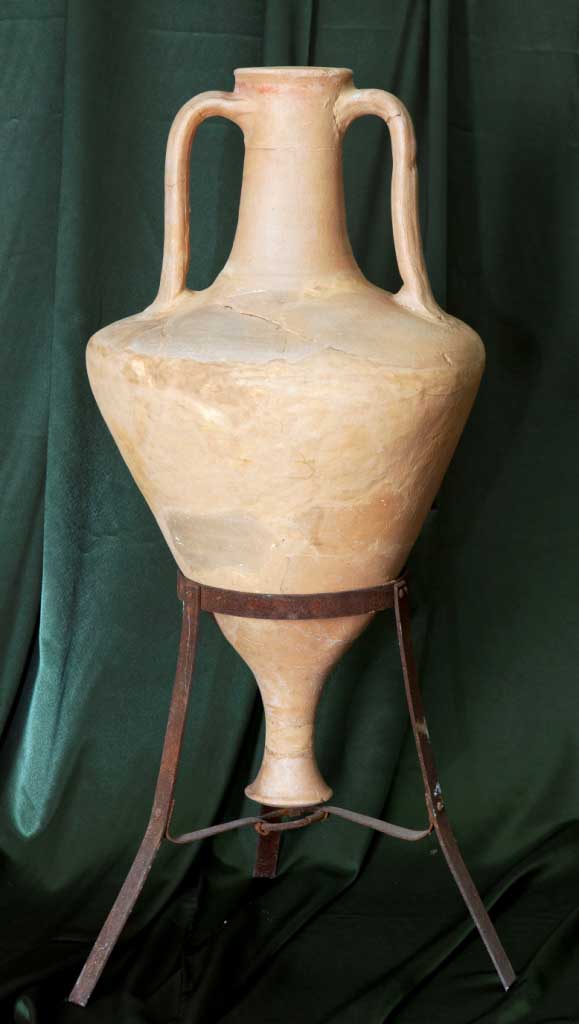  #Exhibit of the Month #Exhibit of the Month
November 2022
Mende amphora from Dubăsari
 Amphoras are massive vessels originating from the ancient Greek world, executed on the potter's wheel, in which Greek merchants, in the process of their trade with other territories and peoples, transported, in particular, Greek wine, olive oil, salted olives, paints, nuts, etc. The shape of the Greek commercial amphora, in the opinion of some researchers, vaguely recalls the female figure, having, probably, at the beginning, a sacred character. Among the main features of the amphorae are well-thought-out metric proportions. The full amphora, placed in a horizontal position, rested on the body and on the elongated foot in such a way that the upper part of the vessel and the high neck were permanently raised obliquely, so that the liquid would not spill. The sharp shape of the foot required special fixation, either on special supports, or the lower part of the body was buried in the ground or sand. The deep inner cavity of the leg did not allow the liquid in the vessel to become cloudy during the transport process, the sediments remaining stored inside the leg.
Amphoras are massive vessels originating from the ancient Greek world, executed on the potter's wheel, in which Greek merchants, in the process of their trade with other territories and peoples, transported, in particular, Greek wine, olive oil, salted olives, paints, nuts, etc. The shape of the Greek commercial amphora, in the opinion of some researchers, vaguely recalls the female figure, having, probably, at the beginning, a sacred character. Among the main features of the amphorae are well-thought-out metric proportions. The full amphora, placed in a horizontal position, rested on the body and on the elongated foot in such a way that the upper part of the vessel and the high neck were permanently raised obliquely, so that the liquid would not spill. The sharp shape of the foot required special fixation, either on special supports, or the lower part of the body was buried in the ground or sand. The deep inner cavity of the leg did not allow the liquid in the vessel to become cloudy during the transport process, the sediments remaining stored inside the leg. Among the dozens of city-states in ancient Greece, which practiced trade with the local populations of the Black Sea region (Euxine Bridge), there is also the city of Mende (Μένδη), located on the Kassandra arm (Κασσάνδρας) of the Halkidiki peninsula (Halkidiki - Χαλκιδική). It is considered that the foundation of the city of Mende took place in the century VIII BC. The main article of trade of this Greek polis was wine, considered of superior quality and even indicated by Hippocrates as a medicine in the treatment of certain diseases. Starting with the century 6th century BC, the city of Mende experienced economic growth, especially in the Circumpontian region, and in the V-IV BC Mendiot wine appears more and more frequently in the local markets of this region. Even some barbarian tribes, according to the Greek tradition, often used wine amphorae in the funeral process, when they were placed, as an offering, in the graves, together with other objects, which were either brought as an offering to the gods, or were intended to serve the deceased in the afterlife. Such a funerary complex was discovered by archaeologist Nicolae Chetraru in 1987 - the Scythian tumulus no. 45 from Dubăsari. The deceased was cremated, and three amphorae and a large bronze cauldron were placed in the grave. Among the amphorae (all belonging to Greek wine centers) was one from Mende, along with two others from Chios. Since the wines of Mende and Chios were considered expensive wines, as was the bronze cauldron, their presence in this mound was an indication of a privileged financial and social position of the person cremated here. The Mende amphora from tomb 1 of mound 45 at Dubăsari is, at the moment, the only complete vessel from this center on the territory of the Republic. Moldova, although fragments of Mendiot amphorae have also been discovered in other archaeological sites in the country. The vessel is made of a yellowish-brown paste with chewed sand and many particles of mica. The amphora has the following basic dimensions: height - 740 mm, depth - 610 mm, maximum diameter - 390 mm.
|


















































